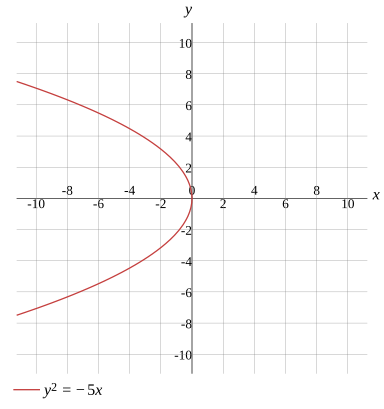Question
Identify the conic
Find the vertex of the parabola
Find the focus of the parabola
Find the directrix of the parabola
(0,0)
Rewrite in standard form
y2=−5x
Solution
(0,0)
Show Solution

Solve the equation
Solve for x
Solve for y
x=−5y2
Evaluate
y2=−5x
Swap the sides of the equation
−5x=y2
Change the signs on both sides of the equation
5x=−y2
Divide both sides
55x=5−y2
Divide the numbers
x=5−y2
Solution
x=−5y2
Show Solution

Testing for symmetry
Testing for symmetry about the origin
Testing for symmetry about the x-axis
Testing for symmetry about the y-axis
Not symmetry with respect to the origin
Evaluate
y2=−5x
To test if the graph of y2=−5x is symmetry with respect to the origin,substitute -x for x and -y for y
(−y)2=−5(−x)
Evaluate
y2=−5(−x)
Evaluate
y2=5x
Solution
Not symmetry with respect to the origin
Show Solution

Find the first derivative
Find the derivative with respect to x
Find the derivative with respect to y
dxdy=−2y5
Calculate
y2=−5x
Take the derivative of both sides
dxd(y2)=dxd(−5x)
Calculate the derivative
More Steps


Evaluate
dxd(y2)
Use differentiation rules
dyd(y2)×dxdy
Use dxdxn=nxn−1 to find derivative
2ydxdy
2ydxdy=dxd(−5x)
Calculate the derivative
More Steps


Evaluate
dxd(−5x)
Use differentiation rule dxd(cf(x))=c×dxd(f(x))
−5×dxd(x)
Use dxdxn=nxn−1 to find derivative
−5×1
Any expression multiplied by 1 remains the same
−5
2ydxdy=−5
Divide both sides
2y2ydxdy=2y−5
Divide the numbers
dxdy=2y−5
Solution
dxdy=−2y5
Show Solution

Find the second derivative
Find the second derivative with respect to x
Find the second derivative with respect to y
dx2d2y=−4y325
Calculate
y2=−5x
Take the derivative of both sides
dxd(y2)=dxd(−5x)
Calculate the derivative
More Steps


Evaluate
dxd(y2)
Use differentiation rules
dyd(y2)×dxdy
Use dxdxn=nxn−1 to find derivative
2ydxdy
2ydxdy=dxd(−5x)
Calculate the derivative
More Steps


Evaluate
dxd(−5x)
Use differentiation rule dxd(cf(x))=c×dxd(f(x))
−5×dxd(x)
Use dxdxn=nxn−1 to find derivative
−5×1
Any expression multiplied by 1 remains the same
−5
2ydxdy=−5
Divide both sides
2y2ydxdy=2y−5
Divide the numbers
dxdy=2y−5
Use b−a=−ba=−ba to rewrite the fraction
dxdy=−2y5
Take the derivative of both sides
dxd(dxdy)=dxd(−2y5)
Calculate the derivative
dx2d2y=dxd(−2y5)
Use differentiation rules
dx2d2y=−25×dxd(y1)
Rewrite the expression in exponential form
dx2d2y=−25×dxd(y−1)
Calculate the derivative
More Steps


Evaluate
dxd(y−1)
Use differentiation rules
dyd(y−1)×dxdy
Use dxdxn=nxn−1 to find derivative
−y−2dxdy
dx2d2y=−25(−y−2dxdy)
Rewrite the expression
dx2d2y=−25(−y2dxdy)
Calculate
dx2d2y=2y25dxdy
Use equation dxdy=−2y5 to substitute
dx2d2y=2y25(−2y5)
Solution
More Steps


Calculate
2y25(−2y5)
Multiply the terms
More Steps


Evaluate
5(−2y5)
Multiplying or dividing an odd number of negative terms equals a negative
−5×2y5
Multiply the terms
−2y5×5
Multiply the terms
−2y25
2y2−2y25
Multiply by the reciprocal
−2y25×2y21
Multiply the terms
−2y×2y225
Multiply the terms
More Steps


Evaluate
2y×2y2
Multiply the numbers
4y×y2
Multiply the terms
4y3
−4y325
dx2d2y=−4y325
Show Solution

Rewrite the equation
r=0r=−5cos(θ)csc2(θ)
Evaluate
y2=−5x
Move the expression to the left side
y2+5x=0
To convert the equation to polar coordinates,substitute x for rcos(θ) and y for rsin(θ)
(sin(θ)×r)2+5cos(θ)×r=0
Factor the expression
sin2(θ)×r2+5cos(θ)×r=0
Factor the expression
r(sin2(θ)×r+5cos(θ))=0
When the product of factors equals 0,at least one factor is 0
r=0sin2(θ)×r+5cos(θ)=0
Solution
More Steps


Factor the expression
sin2(θ)×r+5cos(θ)=0
Subtract the terms
sin2(θ)×r+5cos(θ)−5cos(θ)=0−5cos(θ)
Evaluate
sin2(θ)×r=−5cos(θ)
Divide the terms
r=−sin2(θ)5cos(θ)
Simplify the expression
r=−5cos(θ)csc2(θ)
r=0r=−5cos(θ)csc2(θ)
Show Solution

Graph
